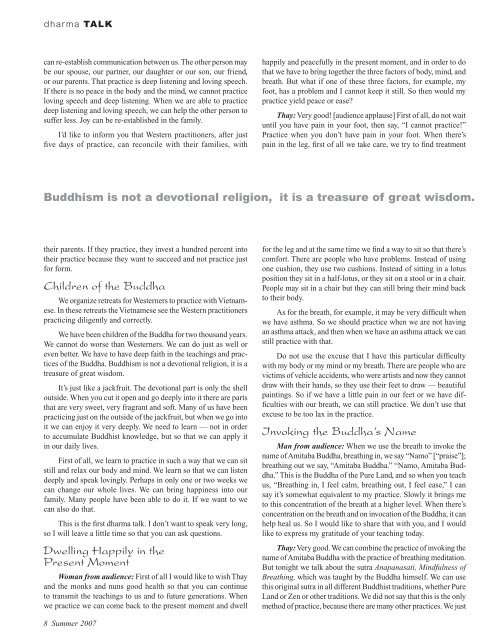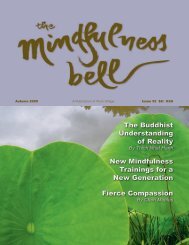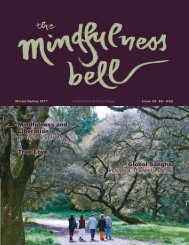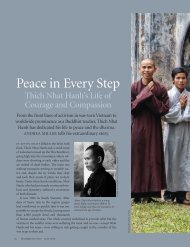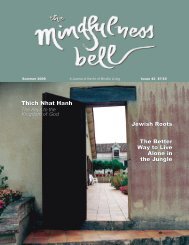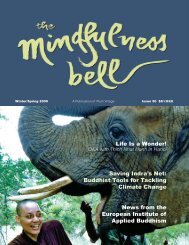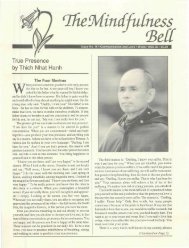Thich Nhat Hanh Healing in Vietnam The Wonderful World of Gathas
Thich Nhat Hanh Healing in Vietnam The Wonderful World of Gathas
Thich Nhat Hanh Healing in Vietnam The Wonderful World of Gathas
- No tags were found...
You also want an ePaper? Increase the reach of your titles
YUMPU automatically turns print PDFs into web optimized ePapers that Google loves.
dharma TALKcan re-establish communication between us. <strong>The</strong> other person maybe our spouse, our partner, our daughter or our son, our friend,or our parents. That practice is deep listen<strong>in</strong>g and lov<strong>in</strong>g speech.If there is no peace <strong>in</strong> the body and the m<strong>in</strong>d, we cannot practicelov<strong>in</strong>g speech and deep listen<strong>in</strong>g. When we are able to practicedeep listen<strong>in</strong>g and lov<strong>in</strong>g speech, we can help the other person tosuffer less. Joy can be re-established <strong>in</strong> the family.I’d like to <strong>in</strong>form you that Western practitioners, after justfive days <strong>of</strong> practice, can reconcile with their families, withhappily and peacefully <strong>in</strong> the present moment, and <strong>in</strong> order to dothat we have to br<strong>in</strong>g together the three factors <strong>of</strong> body, m<strong>in</strong>d, andbreath. But what if one <strong>of</strong> these three factors, for example, myfoot, has a problem and I cannot keep it still. So then would mypractice yield peace or ease?Thay: Very good! [audience applause] First <strong>of</strong> all, do not waituntil you have pa<strong>in</strong> <strong>in</strong> your foot, then say, “I cannot practice!”Practice when you don’t have pa<strong>in</strong> <strong>in</strong> your foot. When there’spa<strong>in</strong> <strong>in</strong> the leg, first <strong>of</strong> all we take care, we try to f<strong>in</strong>d treatmentBuddhism is not a devotional religion, it is a treasure <strong>of</strong> great wisdom.their parents. If they practice, they <strong>in</strong>vest a hundred percent <strong>in</strong>totheir practice because they want to succeed and not practice justfor form.Children <strong>of</strong> the BuddhaWe organize retreats for Westerners to practice with <strong>Vietnam</strong>ese.In these retreats the <strong>Vietnam</strong>ese see the Western practitionerspractic<strong>in</strong>g diligently and correctly.We have been children <strong>of</strong> the Buddha for two thousand years.We cannot do worse than Westerners. We can do just as well oreven better. We have to have deep faith <strong>in</strong> the teach<strong>in</strong>gs and practices<strong>of</strong> the Buddha. Buddhism is not a devotional religion, it is atreasure <strong>of</strong> great wisdom.It’s just like a jackfruit. <strong>The</strong> devotional part is only the shelloutside. When you cut it open and go deeply <strong>in</strong>to it there are partsthat are very sweet, very fragrant and s<strong>of</strong>t. Many <strong>of</strong> us have beenpractic<strong>in</strong>g just on the outside <strong>of</strong> the jackfruit, but when we go <strong>in</strong>toit we can enjoy it very deeply. We need to learn — not <strong>in</strong> orderto accumulate Buddhist knowledge, but so that we can apply it<strong>in</strong> our daily lives.First <strong>of</strong> all, we learn to practice <strong>in</strong> such a way that we can sitstill and relax our body and m<strong>in</strong>d. We learn so that we can listendeeply and speak lov<strong>in</strong>gly. Perhaps <strong>in</strong> only one or two weeks wecan change our whole lives. We can br<strong>in</strong>g happ<strong>in</strong>ess <strong>in</strong>to ourfamily. Many people have been able to do it. If we want to wecan also do that.This is the first dharma talk. I don’t want to speak very long,so I will leave a little time so that you can ask questions.Dwell<strong>in</strong>g Happily <strong>in</strong> thePresent MomentWoman from audience: First <strong>of</strong> all I would like to wish Thayand the monks and nuns good health so that you can cont<strong>in</strong>ueto transmit the teach<strong>in</strong>gs to us and to future generations. Whenwe practice we can come back to the present moment and dwellfor the leg and at the same time we f<strong>in</strong>d a way to sit so that there’scomfort. <strong>The</strong>re are people who have problems. Instead <strong>of</strong> us<strong>in</strong>gone cushion, they use two cushions. Instead <strong>of</strong> sitt<strong>in</strong>g <strong>in</strong> a lotusposition they sit <strong>in</strong> a half-lotus, or they sit on a stool or <strong>in</strong> a chair.People may sit <strong>in</strong> a chair but they can still br<strong>in</strong>g their m<strong>in</strong>d backto their body.As for the breath, for example, it may be very difficult whenwe have asthma. So we should practice when we are not hav<strong>in</strong>gan asthma attack, and then when we have an asthma attack we canstill practice with that.Do not use the excuse that I have this particular difficultywith my body or my m<strong>in</strong>d or my breath. <strong>The</strong>re are people who arevictims <strong>of</strong> vehicle accidents, who were artists and now they cannotdraw with their hands, so they use their feet to draw — beautifulpa<strong>in</strong>t<strong>in</strong>gs. So if we have a little pa<strong>in</strong> <strong>in</strong> our feet or we have difficultieswith our breath, we can still practice. We don’t use thatexcuse to be too lax <strong>in</strong> the practice.Invok<strong>in</strong>g the Buddha’s NameMan from audience: When we use the breath to <strong>in</strong>voke thename <strong>of</strong> Amitaba Buddha, breath<strong>in</strong>g <strong>in</strong>, we say “Namo” [“praise”];breath<strong>in</strong>g out we say, “Amitaba Buddha.” “Namo, Amitaba Buddha.”This is the Buddha <strong>of</strong> the Pure Land, and so when you teachus, “Breath<strong>in</strong>g <strong>in</strong>, I feel calm, breath<strong>in</strong>g out, I feel ease,” I cansay it’s somewhat equivalent to my practice. Slowly it br<strong>in</strong>gs meto this concentration <strong>of</strong> the breath at a higher level. When there’sconcentration on the breath and on <strong>in</strong>vocation <strong>of</strong> the Buddha, it canhelp heal us. So I would like to share that with you, and I wouldlike to express my gratitude <strong>of</strong> your teach<strong>in</strong>g today.Thay: Very good. We can comb<strong>in</strong>e the practice <strong>of</strong> <strong>in</strong>vok<strong>in</strong>g thename <strong>of</strong> Amitaba Buddha with the practice <strong>of</strong> breath<strong>in</strong>g meditation.But tonight we talk about the sutra Anapanasati, M<strong>in</strong>dfulness <strong>of</strong>Breath<strong>in</strong>g, which was taught by the Buddha himself. We can usethis orig<strong>in</strong>al sutra <strong>in</strong> all different Buddhist traditions, whether PureLand or Zen or other traditions. We did not say that this is the onlymethod <strong>of</strong> practice, because there are many other practices. We just8 Summer 2007


